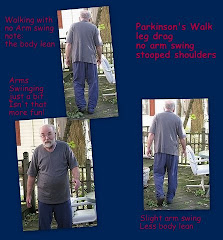Blue, Moon and PD
Since the mid-1990s PDers have heard that blue lens glasses can help eliminate some PD symptoms. Now there is a Parkinson's disease dystonia video on youtube.com which is nothing short of astonishing. The original video was made in 2003 while the gentleman was being given a UPDRS. Alas, this video has recently been removed from youtube site and that affects several sites which backlinked to it.
In the video the PD patient filmed has a severe dystonia attack, his body literally rolls from the waist, through the shoulders, neck and head. And then the therapist or nurse holds an 8"x11" sheet of blue plastic in front of his face. He takes it, rises from the chair and within seconds the dystonia is gone and he is walking rhythmically around the room. Each time the sheet of blue plastic is in front of his eyes the dystonia ceases. A slight tremor remains in his hand but that is all.
Presently there is no scientific explanation for how this is happening. One theory is that different organs of the body have different signatures of vibration, when the vibrations get out of sync they cause illness,blue light has the ability to correct the balance.
Dystonia can develop as a side effect of dopamine replacement therapy - levodopa - or it can be a separate neurological condition. It is characterized by sustained contractions which can cause twisting, repetitive movements, and/or painful postures. Dystonia can affect the arms, legs, trunk, neck, head or face. It is estimated that there are at least 1.2 million people in the USA with PD-LID (Parkinson's Disease with levodopa induced dystonia)
Dystonia is essentially a subset of dyskinesia. Characterised by abnormal movements, decreased voluntary movement and the presence of involuntary movements, dyskinesia is a symptom of several conditions which are distinguised by the root cause. In Parkinson's disease, it is often seen as a purposless motions, uncontrolled and often rapid, interrupting normal movement or posture. In dystonia there are sustained muscle contractions which cause involuntary twisting, repetitve movement, abnormal posture often resulting in constant pain, cramps and muscle spasms.
We have read reports from 1995 of people who had prescription glasses made with blue lenses and found significant improvement with stiffness and fine motor skills although not as much as a plain blue overlay because of the additional gray tint to the blue of the optical blue lenses. Another woman with PD reported that often in the morning she would freeze and not be able to get out of bed. Her husband would put the blue glasses on her face and she would be able to move again. Still another women reported that the blue glasses helped her with both dyskinesia and with asthma attacks.
It is known that in dyslexia color can play a significant role. Dyslexia is associated with both grey and white matter dysfunction and altered connectivity among phonological/reading areas. There are altered densities of grey and white matter in the frontal lobe and in the white matter neural pathway connecting the temporparietal junction with the frontal cortex.
My wife recalled that 20 years ago our son had a friend with reading problems due to dyslexia. His father, an educator, decided to try putting colored overlays over Matt's reading material to see if that helped. Blue seemed to do the trick.
It also turns out that a light blue background, as opposed to white, appears to be the most effective tint. But what can be the biggest help is putting an overlay in front of your computer screen or over your paper reading material. As a matter of fact you can buy the overlays for reading a book as well as for your monitor screen.
There are some very specific instructions for creating the exact shade of blue and these can be found at CALIPSO. It appears that both the overlays and the sunglass style glasses that we bought work also. You do want to be sure that the blue you try is not on the grey side because that will reduce the effectiveness.
I don't suffer from dystonia and I've outgrown my youthful asthma but I've been wearing blue glasses every day for about 30-40 minutes and I think they have been helping me to be calmer and less tense while I'm wearing them. Relief of stress is important to me. Ten years ago these glasses would never have gotten near the bridge of my nose, it being too busy sneering at them. But having PD has opened my mind to the mysteries of the brain's operation.
Trying to understand and gain insight
Additional BLUE reading for Parkinson's disease:
Intuitive Colorimeter - with thanks to Peter Austin
How to use the Intuitive Colorimeter
Addenda 2016
Tinted lenses and dystonia - appears to be something of a speculation.
Thank you to a very thoughtful gentleman for providing this link to the blue lens and blue gel dystonia test.
Addenda 2016
Tinted lenses and dystonia - appears to be something of a speculation.
Thank you to a very thoughtful gentleman for providing this link to the blue lens and blue gel dystonia test.





















